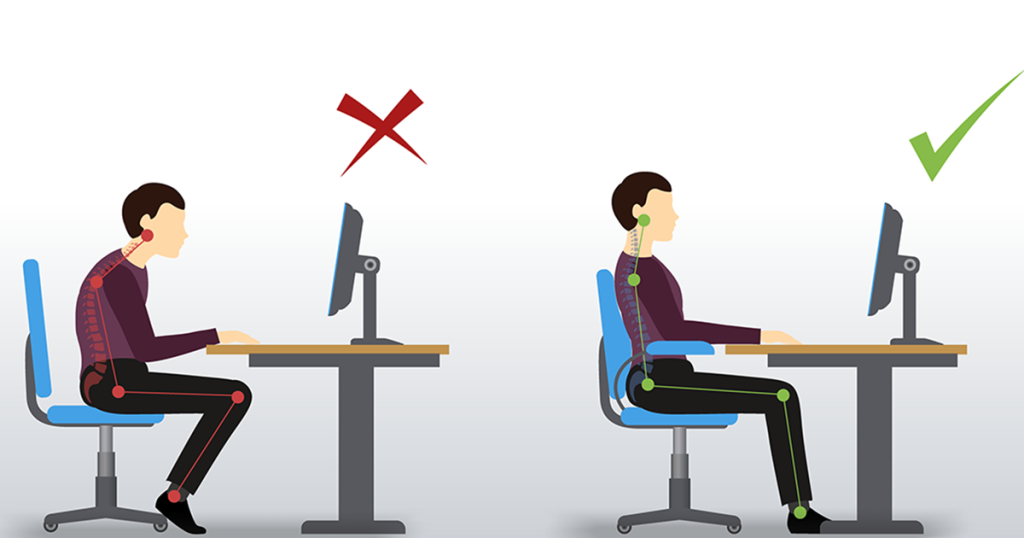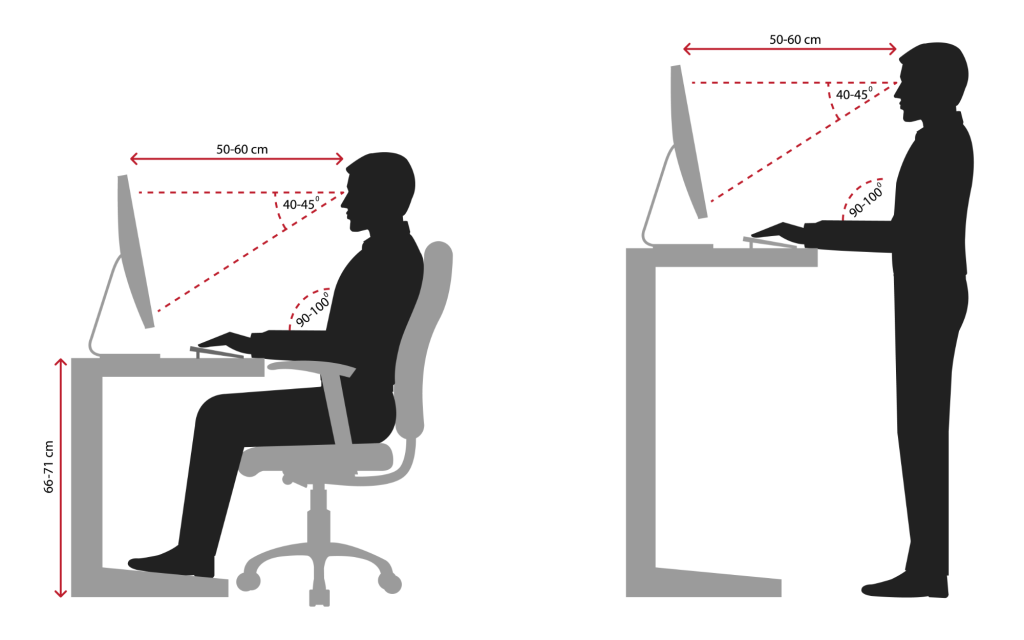Workplace Ergonomics
Why Are They So Important When It Comes to Avoiding Pain in the Back and Shoulders?

In today’s modern work environment, many people spend hours sitting at desks, typing on computers, or performing repetitive tasks. While this may seem harmless, improper posture and poor workplace ergonomics can lead to significant pain and discomfort, especially in the back and shoulders. These areas are highly susceptible to strain, and without proper ergonomic practices, the consequences can range from chronic pain to serious musculoskeletal injuries. In this blog, we’ll explore why workplace ergonomics are essential for preventing back and shoulder pain, how they can improve overall well-being, and practical steps you can take to create an ergonomic workspace.
The Importance of Workplace Ergonomics
Workplace ergonomics refers to designing and arranging workspaces to optimise comfort, safety, and productivity. It involves adjusting the workspace layout, tools, and equipment to align with the natural movement of the body and prevent strain on muscles and joints. When ergonomics are prioritised, employees can avoid repetitive strain injuries (RSIs), musculoskeletal disorders (MSDs), and other issues related to prolonged sitting or poor posture.
One of the most common health complaints related to poor ergonomics is back and shoulder pain. The spine and shoulders bear much of the body’s weight, and improper posture or workstation setup can cause undue stress on these areas, leading to discomfort or long-term injury.
How Poor Ergonomics Contribute to Back and Shoulder Pain
When you spend long hours sitting in front of a desk, it’s easy for your posture to deteriorate. Slouching, hunching forward, or twisting your spine to reach for items can all lead to strain. For example, if your workstation is not set up correctly, you may find yourself reaching or bending in unnatural positions, placing stress on your back and shoulders. Over time, these poor habits can lead to muscle fatigue, stiffness, and inflammation.
The back and shoulders are especially vulnerable to these stressors. The back, particularly the lower spine, is designed to support the body’s weight and distribute it evenly during movement. However, when sitting improperly for long periods, the spine is not properly aligned, causing increased pressure on discs and joints. Similarly, the shoulders are often overworked when poor posture causes the arms to rest in awkward positions, leading to muscle tension, nerve compression, and reduced circulation (Miller, 2023).
Furthermore, repeated actions such as typing, clicking a mouse, or lifting objects improperly can contribute to repetitive strain injuries (RSIs), which often present as discomfort or pain in the back, neck, shoulders, and wrists. When left unaddressed, these conditions can become chronic and significantly impact an individual’s quality of life.
The Benefits of Ergonomics in Preventing Pain
By implementing workplace ergonomics, employees can reduce the risk of developing back and shoulder pain. Proper ergonomic practices ensure that the body is supported in natural, comfortable positions, preventing strain and injury.
1. Improved Posture
One of the key components of ergonomic practices is maintaining proper posture. For example, ensuring that your chair supports the natural curve of your spine can help keep the back aligned, reducing stress on muscles and joints. A proper chair height and desk alignment also prevent the shoulders from becoming tense or elevated, which often leads to discomfort and pain.
2. Reduced Muscle Strain
Ergonomics emphasise the use of the right equipment to reduce unnecessary strain. For instance, a properly positioned keyboard and mouse can help prevent shoulder and wrist strain. Adjusting the height of your workstation can eliminate the need to twist or overreach, reducing stress on the back and shoulders.
3. Increased Circulation
Good ergonomics promote better blood flow. Sitting or standing in the same position for too long can hinder circulation and cause discomfort. Regular movement and incorporating ergonomic adjustments like a sit-stand desk can help maintain circulation, preventing stiffness and soreness.
4. Enhanced Comfort and Productivity
When employees are comfortable and free from pain, their ability to concentrate and perform their tasks improves. Ergonomically designed workspaces reduce distractions caused by pain and discomfort, leading to better overall productivity and fewer sick days due to musculoskeletal disorders (Brodywn, 2023).

Key Ergonomic Practices to Prevent Back and Shoulder Pain
Now that we understand the importance of workplace ergonomics, let’s look at some key practices to help prevent back and shoulder pain:
1. Proper Chair Support
Ensure your chair is adjustable and provides lumbar support to maintain the natural curve of your spine. Your feet should rest flat on the floor, with your knees at a 90-degree angle. If necessary, use a footrest to ensure proper alignment.
2. Desk Height
Your desk should be at a height where your elbows are bent at a 90-degree angle when typing or using a mouse. Keep your forearms parallel to the floor to prevent strain on your shoulders and wrists.
3. Monitor Positioning
Your monitor should be at eye level to avoid straining your neck. The top of the screen should be at or just below your eye level when sitting comfortably in your chair. Keep the monitor about an arm’s length away from your face.
4. Take Frequent Breaks
Sitting for long periods can lead to muscle fatigue and discomfort. Stand up, stretch, and move around every 30 to 60 minutes. Short breaks help relieve tension in the back and shoulders and promote blood flow.
5. Keyboard and Mouse Placement
Your keyboard and mouse should be positioned in a way that allows your arms to remain close to your body, with your wrists straight and relaxed. Avoid excessive reaching, and keep your arms at a comfortable angle to reduce strain on the shoulders.
6. Lift Correctly
If your job requires lifting objects, always bend your knees and use your legs to lift, rather than bending at the waist. This reduces the strain on your lower back and prevents potential injury.
7. Use a Standing Desk
If possible, alternate between sitting and standing throughout the day. A sit-stand desk can allow you to switch positions, reducing the strain on your back and shoulders.
Conclusion
Workplace ergonomics play a critical role in preventing back and shoulder pain, especially in jobs that require prolonged sitting, repetitive motions, or lifting. By prioritising ergonomic practices—such as proper posture, desk setup, and regular movement—you can significantly reduce the risk of developing musculoskeletal disorders, improve comfort, and enhance productivity.
If you’re experiencing persistent pain or discomfort in your back or shoulders, it may be a sign that your workspace needs an ergonomic overhaul. Taking the time to make small adjustments can have a big impact on your long-term health and well-being. Remember, a healthy workspace equals a healthy you.

References:
- Dr. Anthony Miller. (2023). The Importance of Workplace Ergonomics in Preventing Back and Shoulder Pain. Retrieved from https://www.dranthonymiller.com/the-importance-of-workplace-ergonomics-in-preventing-back-and-shoulder-pain
- Dr. Jay Brodwyn. (2023). Why Are Workplace Ergonomics So Important When It Comes to Avoiding Pain in the Back and Shoulders?. Retrieved from https://www.drjaybrodwyn.com/blog/posts/why-are-workplace-ergonomics-so-important-when-it-comes-to-avoiding-pain-in-the-back-and-shoulders
- Mayo Clinic. (2023). Office Ergonomics. Retrieved from https://www.mayoclinic.org/healthy-lifestyle/adult-health/in-depth/office-ergonomics/art-20046169
- RRP. (2023). Why Ergonomics Is Important in the Workplace. Retrieved from https://www.rrp.com.au/why-ergonomics-is-important-in-the-workplace
- UCLA Health. (2023). Ergonomics for Prolonged Sitting. Retrieved from https://www.uclahealth.org/medical-services/spine/patient-resources/ergonomics-prolonged-sitting
- Spine Health. (2023). Spine Posture and Workplace Ergonomics. Retrieved from https://spinehealth.org/article/spine-posture-workplace-ergonomics
- Rehab Management. (2023). Back, Shoulder, or Neck Pain? It Could Be Your Office Ergonomics. Retrieved from https://www.rehabmanagement.com.au/news/back-shoulder-or-neck-pain-it-could-be-your-office-ergonomics/
- Tulane University. (2023). Workplace Ergonomics & Safety. Retrieved from https://publichealth.tulane.edu/blog/workplace-ergonomics-safety


